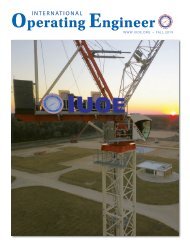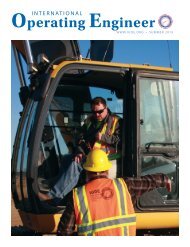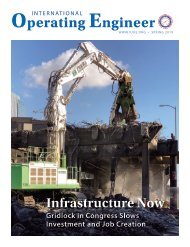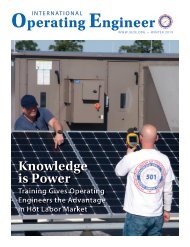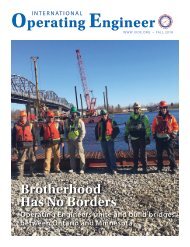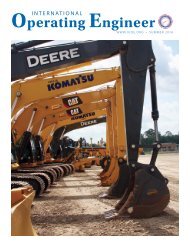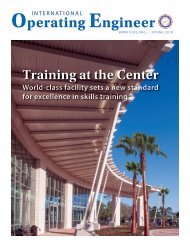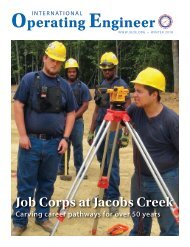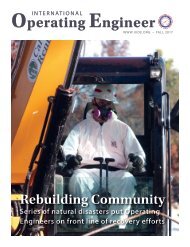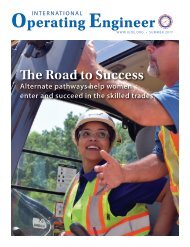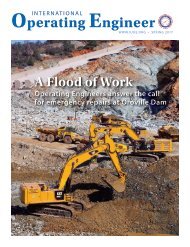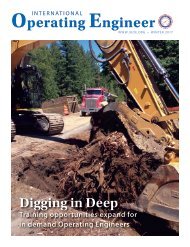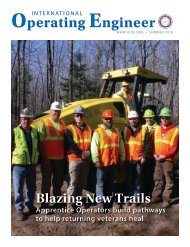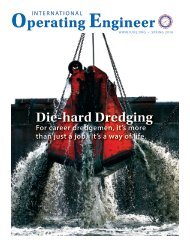125 Years Strong – An IUOE History
Celebrating the 125th Anniversary of the founding of the International Union of Operating Engineers
Celebrating the 125th Anniversary of the founding of the International Union of Operating Engineers
You also want an ePaper? Increase the reach of your titles
YUMPU automatically turns print PDFs into web optimized ePapers that Google loves.
INTERNATIONAL UNION OF OPERATING ENGINEERS<br />
that resulted in the “temporary organization”<br />
of the N.U.S.E. (which had become the<br />
International Union of Steam and Operating<br />
Engineers by the time he wrote the letter):<br />
N.U.S.E./I.U.O.E.<br />
INITIAL LEADERSHIP<br />
Steam engineers work on the Chicago<br />
Sanitary and Ship Canal in 1895, the year<br />
before the National Union of Steam Engineers<br />
(which would become the International<br />
Union of Operating Engineers) was formed.<br />
When it opened in 1900, the 28-mile canal<br />
project, the largest earth-moving operation<br />
in North America up to that time, connected<br />
Lake Michigan to the Des Plaines River and<br />
allowed for the reversal of the flow of the<br />
Chicago River. (Photos courtesy of the Chicago<br />
Metropolitan Water Reclamation District.)<br />
24 that year that the three steam engineers’<br />
delegates met with the convention hall’s<br />
engineer, Brother John R. Lyon, a member<br />
of the Cincinnati engineers’ local union, to<br />
further discuss forming a national union of<br />
steam engineers.<br />
Several years afterward in a letter in the<br />
January 1918 issue of the International<br />
Steam Engineer, the union’s monthly journal<br />
for members, Brother Lyon conveyed this<br />
account of that meeting and the subsequent<br />
formal gathering on December 18, 1896,<br />
“Upon the second or third day of the convention,<br />
we received in the engine room a visit from<br />
the three above named delegates, who stated<br />
that they had called incidentally to visit as one<br />
engineer would upon another socially but, more<br />
prominently, for the purpose of inquiring if we<br />
could inform them if there was such a thing as a<br />
union of engineers in Cincinnati. We had to admit<br />
there were none such, but we stated to them that<br />
there was a body of engineers who held regular<br />
meetings, but whose particular object was that of<br />
promoting and protecting the city laws governing<br />
the licensing of engineers. They then stated that in<br />
their opinion it was about time for the engineers<br />
of the United States to get busy and form a<br />
national organization. We then invited them to<br />
visit our organization on Thursday night, which<br />
they accepted. At that meeting, the three delegates<br />
stated their views, and after some discussion,<br />
the writer was appointed a committee of one to<br />
further confer with them with power to act.<br />
“The next evening, the four of us met at the<br />
boarding place of the delegates on Shillito Street<br />
near Elm and drew up an informal set of rules,<br />
claims and constitution and closed the meeting<br />
by electing the following temporary officers with<br />
instructions to obtain the necessary number of<br />
signatures to obtain a national charter: Brother<br />
DeLong of Chicago, president; Brother Smales of<br />
Denver, secretary; Brother Tomsen of St. Louis,<br />
first vice president; Brother Lyon of Cincinnati,<br />
second vice president.”<br />
(Brother Lyon’s initial tenure with the<br />
N.U.S.E. was short-lived, as his local in<br />
Cincinnati, which had been chartered by the<br />
A.F.L. on June 13, 1888, as Local No. 18, “at<br />
that time was not educated in the principles of<br />
unionism,” as he explained, and therefore did<br />
not initially join the national organization.<br />
However, the local eventually entered the union<br />
After the National Union of Steam Engineers (N.U.S.E.,<br />
which would evolve into the I.U.O.E.) first organized on<br />
December 7, 1896, in Chicago, its first officers selected<br />
during a meeting on December 18, 1896, in Cincinnati were<br />
(listed with respective hometown):<br />
Charles J. DeLong (Chicago), President<br />
L. P. Tomsen (St. Louis), Vice President<br />
John. R. Lyon (Cincinnati), Treasurer<br />
John M. Smales (Denver), Secretary<br />
The following year during the first-ever N.U.S.E. convention<br />
on August 9, 10 and 11, 1897, at Delabar’s Saloon in St.<br />
Louis, the union’s first officers elected by delegates of its<br />
locals were:<br />
Frank Bowker (Boston), President<br />
Frank Pfohl (Syracuse), First Vice-President<br />
Samuel L. Bennett (Kansas City), Second Vice-President<br />
C. J. Frealig (Detroit), Secretary<br />
John M. Smales (Denver), Treasurer<br />
J. M. Davis (Peoria), Trustee<br />
M. J. Moran (Toledo), Trustee<br />
Samuel Yetting (Kansas City), Trustee<br />
on June 13, 1898, and continued as Local No.<br />
18 until it was amalgamated with Local No.<br />
906 on July 1, 1930, to become Local No. 20,<br />
with which Brother Lyon remained active until<br />
his death on March 24, 1942, at age 92.)<br />
Essential Craft for The Nation<br />
“The history of our organization<br />
thus far is a history of unending<br />
struggle. The beginnings of the craft<br />
were bad; and the spirit in which the<br />
calling was regarded, especially by<br />
employers, and to some extent by the<br />
men pursuing it, were even worse.”<br />
<strong>–</strong> The International Steam Engineer, September 1912<br />
Prior to December 7, 1896, when those 11<br />
founding fathers took the first steps toward<br />
forming the I.U.O.E., the steam-engineering<br />
trade’s overall condition and financial prospects<br />
LABOR OMNIA VINCIT<br />
WORK CONQUERS ALL



